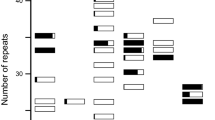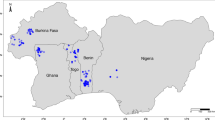Abstract
Sustained harvest of wild North Americanginseng (Panax quinquefolius L.) for overtwo centuries has led to heightenedconservation concern and a recent interest inthe population genetics of this species. Thisstudy examined allozyme variation from 32 wildand 12 cultivated populations of Americanginseng to: (1) document the amount anddistribution of genetic variation over a wideportion of the species' natural range, (2)examine genetic differences between wild andcultivated populations, and (3) provideindirect estimates of its breeding system. Strong genetic differences between wild andcultivated populations were found in the amountof variation within populations and thedistribution of variation among populations. Wild populations were significantly lower inall within-population diversity measures, butcontained significantly higher levels ofvariation partitioned among populations. Similarities between wild and cultivatedpopulations were also found. As a whole,cultivated and wild groups shared nearly allalleles, and populations of both groups showedstrong homozygote excess compared toexpectations under random mating. Thehomozygote excess is best explained by highlevels of selfing. In wild populations,significant correlations were found betweengenetic diversity and estimated populationsize, and between interpopulation geneticdistance and geographic distance. Overall, theresults for wild populations suggest that theyare influenced by high levels of genetic driftand low migration among populations. Conservation implications for American ginsengare discussed with particular emphases on: (1)the current debate surrounding the existence ofwild populations, (2) the ongoing practice ofintroducing cultivated seed into wildpopulations, and (3) the collection of geneticmaterial for the establishment of breedingprograms.
Similar content being viewed by others
References
Ammerman AJ, Cavalli-Sforza LL (1984) The analysis of genes. In: The Neolithic Transition and The Genetics of Populations in Europe, pp. 85–108. Princeton University Press, Princeton.
Anderson RC, Fralish JS, Armstrong JE, Benjamin PK (1993) The ecology and biology of Panax quinquefoliumL. (Araliaceae) in Illinois. Am. Midl. Nat., 129, 357–372.
Bai D, Brandle J, Reeleder R (1997) Genetic diversity in North American ginseng (Panax quinquefoliusL.) grown in Ontario detected by RAPD analysis. Genome, 40, 111–115.
Boehm CL, Harrison HC, Jung G, Nienhuis J (1999) Organization of American and Asian ginseng germplasm using randomly amplified polymorphic DNA (RAPD) markers. J. Amer. Soc. Hort. Sci., 124, 252–256.
Carlson AW (1986) Ginseng: America's botanical drug connection to the orient. Econ. Bot., 40, 233–249.
Carpenter SG, Cottam G (1982) Growth and reproduction of American ginseng (Panax quinquefolius) in Wisconsin, USA. Can. J. Bot., 60, 2692–2696.
Carr DE, Dudash MR (1996) Inbreeding depression in two species of Mimulus(Scrophulariaceae) with contrasting mating systems. Amer. J. Bot., 83, 586–593.
Case MA (1993) High levels of allozyme variation within Cypripedium calceolus(Orchidaceae) and low levels of divergence among its varieties. Syst. Bot., 18, 663–677.
Charron D, Gagnon D (1991) The demography of northern populations of Panax quinquefolium(American ginseng). J. Ecol., 79, 431–445.
Crawford DJ (1982) Electrophoresis: Lecture Notes from Botany 812, 3rd edn., fall quarter. Ohio State University, Columbus, OH.
Ellstrand NC, Elam DR (1993) Population genetic consequences of small population size: Implications for plant conservation. Annu. Rev. Ecol. Syst., 24, 217–242.
Fischer M, Matthies D (1997) Mating Structure and inbreeding and outbreeding depression in the rare plant Gentianella germanica(Gentianaceae). Amer. J. Bot., 84, 1685–1692.
Frankel OH, Brown AHD, Burdon JJ (1995) The genetic diversity of cultivated plants. In: The Conservation of Plant Biodiversity, pp. 39–78. Cambridge University Press, Cambridge.
Gastony GJ (1991) Gene silencing in a polyploid homosporous fern: Paleopolyploidy revisited. Proc. Natl. Acad. Sci. USA, 88, 1602–1605.
Gilpin ME, Soulé ME (1986) Minimum viable populations: Processes of species extinction. In: Conservation Biology: The Science of Scarcity and Diversity (ed. Soulé ME), pp. 19–34. Sinauer, Sunderland, MA.
Gleason HA, Cronquist A (1991) Manual of Vascular Plants of Northeastern United States and Adjacent Canada, 2nd edn. The New York Botanical Garden, New York.
Gottlieb LD (1981) Gene number in species of Astereae that have different chromosome numbers. Proc. Natl. Acad. Sci. USA, 78, 3726–3729.
Grubbs HJ (2001) Allozyme Variation in American Ginseng, Panax quinquefolius L. (Araliaceae): Implications for Management of Wild and Cultivated Populations. MA thesis, The College of William and Mary, Williamsburg, VA.
Hamrick JL, Godt MJW (1989) Allozyme diversity in plant species. In: Plant Population Genetics, Breeding and Genetic Resources (eds. Brown AHD, Clegg MT, Kahler AL, Weir BS), pp. 43–63. Sinauer, Sunderland, MA.
Hankins A (2000) Producing and marketing wild simulated ginseng in forest and agroforestry systems. Virginia Cooperative Extension Publication, Number 354-312.
Harris S (1999) Wild or cultivated? Sylvan Botanicals. http://www. catskillginseng.com/html/sb.htm.
Hedrick PW (1985) Genetics of Populations. Jones and Bartlett Publishers, Boston, MA.
Hu SY, Rüdenberg L, Tredici PD (1980) Studies of American ginsengs. Rhodora, 82, 627–636.
Husband BC, Schemske DW (1997) The effect of inbreeding in diploid and tetraploid populations of Epilobium angustifolium(Onagraceae): Implications for the genetic basis of inbreeding depression. Evolution, 51, 737–746.
James FC, McCulloch CE (1990) Multivariate analysis in ecology and systematics: Panacea or pandora's box? Annu. Rev. Ecol. Syst., 21, 129–166.
Kalm P (1987) Peter Kalm's Travels in North America; the English Version of 1770. Dover Publications, New York.
Krutovskii KV, Erofeeva SY, Aagaard JE, Strauss SH (1999) Simulation of effects of dominance on estimates of population genetic diversity and differentiation. J. Hered., 90, 499–502.
Lewis PO, Zaykin D (2001) Genetic Data Analysis: Computer Program for the Analysis of Allelic Data, Version 1.0 (d16c). http://lewis.eeb.uconn.edu/lewishome/software.html.
Lewis WH, Zenger VE (1982) Population dynamics of the American ginseng Panax quinquefolium(Araliaceae). Amer. J. Bot., 69, 1483–1490.
Lewis WH, Zenger VE (1983) Breeding systems and fecundity in the American ginseng, Panax quinquefolium(Araliaceae). Amer. J. Bot., 70, 466–468.
Lynch M, Milligan BG (1994) Analysis of population genetic structure with RAPD markers. Mol. Ecol., 3, 91–99.
McGraw JB (2001) Evidence for decline in stature of American ginseng plants from herbarium specimens. Biol. Conserv., 98, 25–32.
Michaux FA (1805) Travels to the Westward of the Allegany Mountains, in the States of Ohio, Kentucky, and Tennessee, and Return to Charlestown, Through the Upper Carolinas. J. Mawman, London.
Montgomery ME, Woodworth LM, Nurthen RK, Gilligan DM, Briscoe DA, Frankham R (2000) Relationships between population size and loss of genetic diversity: Comparisons of experimental results with theoretical predictions. Conserv. Genetics, 1, 33–43.
Murphy RW, Sites JW Jr, Buth DG, Haufler CH (1990) Proteins 1: Isozyme electrophoresis. In: Molecular Systematics (eds. Hillis DM, Moritz C), pp. 45–126. Sinauer, Sunderland, MA.
Nash GV (1898) American Ginseng: Its Commercial History, Protection, and Cultivation. US Department of Agriculture Bulletin No. 16, Washington.
Nei M (1973) Analysis of gene diversity in subdivided populations. Proc. Natl. Acad. Sci. USA, 70, 3321–3323.
Nei M (1978) Estimation of average heterozygosity and genetic distance from a small number of individuals. Genetics, 89, 583–590.
Nybom H, Bartish IV (2000) Effects of life history traits and sampling strategies on genetic diversity estimates obtained with RAPD markers in plants. Perspectives in Plant Ecology, Evolution and Systematics, 3, 93–114.
Parker MA (1992) Outbreeding depression in a selfing annual. Evolution, 46, 837–841.
Persons WS (1994) American Ginseng: Green Gold. Bright Mountain Books, Inc, Asheville, NC.
Persons WS (2000) An overview of woodland ginseng production in the United States. In: American Ginseng Production in the 21st Century, pp. 6–11. Cornell Cooperative Extension of Green County, NY.
Robbins CS (1998) American Ginseng: The Root of North America's Medicinal Herb Trade. Traffic North America, Washington DC.
Robbins CS (2000) Comparative analysis of management regimes and medicinal plant trade monitoring mechanisms for American ginseng and goldenseal. Conserv. Biol., 14, 1422–1434.
Rohlf FJ (1988) NTSYS-pc: Numerical Taxonomy and Multivariate Analysis System. Exeter Software, Setauket, NY.
Schlessman MA (1985) Floral biology of American ginseng (Panax quinquefolium). Bull. Torrey Bot. Club, 112, 129–133.
Schlessman MA (1987) Gender modification in North American ginsengs: Dichotomous sex choice versus adjustment. Bioscience, 37, 469–475.
Schluter C, Punja ZK (2000) Floral biology and seed production in cultivated North American ginseng (Panax quinquefolius). J. Amer. Soc. Hort. Sci., 125, 567–575.
Schluter C, Punja ZK (2002) Genetic diversity among natural and cultivated field populations and seed lots of American ginseng (Panax quinquefoliusL.) in Canada. Int. J. Plant Sci., 163, 427–439.
Sokal RR, Rohlf FJ (1995) Biometry: The Principles and Practice of Statistics in Biological Research. WH Freeman and Company, New York.
Soltis DE, Haufler CH, Darrow DC, Gastony GJ (1983) Starch gel electrophoresis of ferns: A compilation of grinding buffers, gel and electrode buffers, and staining schedules. Am. Fern J., 73, 9–27.
Stanton G (1892) The cultivation of ginseng. Garden and Forest 11 May, 223–224.
Swofford DL, Selander RB (1989) BIOSYS-1: A Computer Program for the Analysis of Allelic Variation in Population Genetics and Biochemical Systematics, Release 1.7. Illinois Natural History Survey.
Templeton AR (1986) Coadaptation and outbreeding depression. In: Conservation Biology: The Science of Scarcity and Diversity (ed. Soulé ME), pp. 105–116. Sinauer, Sunderland, MA.
Waser NM, Price MV (1994) Crossing-distance effects in Delphinium nelsonii: Outbreeding depression and inbreeding depression in progeny fitness. Evolution, 48, 842–852.
Weeden NF, Wendel JF (1989) Genetics of plant isozymes. In: Isozymes in Plant Biology (eds. Soltis DE, Soltis PS), pp. 46–72. Dioscorides Press, Portland, OR.
Weir BS, Cockerham CC (1984) Estimating F-statistics for the analysis of population structure. Evolution, 38, 1358–1370.
Williamson PS, Werth CR (1999) Levels and patterns of genetic variation in the endangered species Abronia macrocarpa(Nyctaginaceae). Amer. J. Bot., 86, 293–301.
Author information
Authors and Affiliations
Rights and permissions
About this article
Cite this article
Grubbs, H.J., Case, M.A. Allozyme variation in American ginseng (Panax quinquefolius L.): Variation, breeding system, and implications for current conservation practice. Conservation Genetics 5, 13–23 (2004). https://doi.org/10.1023/B:COGE.0000014064.44592.bc
Issue Date:
DOI: https://doi.org/10.1023/B:COGE.0000014064.44592.bc




